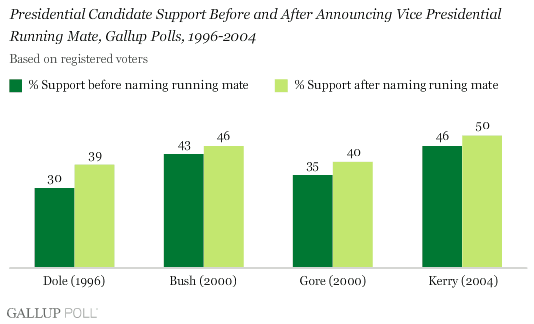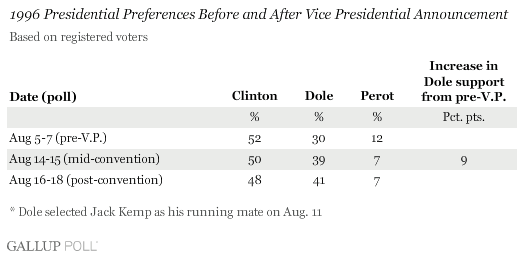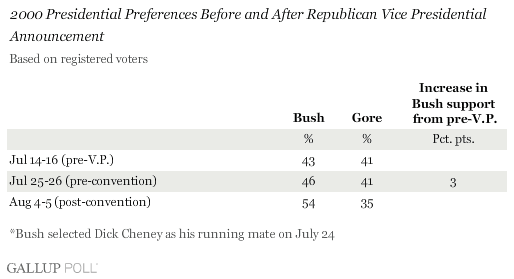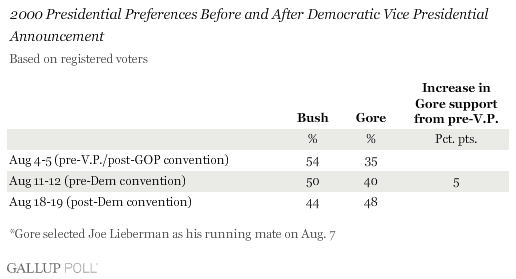PRINCETON, NJ -- With Barack Obama and John McCain poised to announce their vice presidential running mates in the coming weeks, a review of Gallup Poll data finds that, since 1996, presidential candidates have received a slight bump in support in the polls after naming their vice presidential running mates.

Historically, presidential nominations were decided at the party conventions, and as a result, the vice presidential running mates were also selected at the conventions. That made it difficult to disentangle the effect of naming a vice presidential running mate on a candidate's support from the "convention bounce" that presidential candidates have typically received.
The situation has changed in recent elections. With the nominees known long before the conventions take place, presidential candidates have been announcing their vice presidential choices in advance of the conventions. Now that vice presidential announcements are separate events from the conventions, the polls can better isolate any impact the announcement of a running mate has on presidential preferences.
Since 1996, Gallup has conducted polls in the small window of time after the announcement of a presidential candidate's running mate but before the convention has taken place. During this time, there have been four instances of a non-incumbent presidential candidate choosing a running mate -- Bob Dole in 1996, George W. Bush and Al Gore in 2000, and John Kerry in 2004. A comparison of the multi-night polls taken before and after these candidates announced their vice presidential running mates shows an average 5-point increase in the candidate's support.
1996
In 1996, Bill Clinton was seeking a second term as president and Gore a second term as vice president, with Republican Dole challenging them. Dole selected former Congressman and Secretary of Housing and Urban Development Jack Kemp as his running mate on Aug. 11.
Clinton had a commanding lead in the polls through much of the summer, and the last poll before Dole chose Kemp (conducted Aug. 5-7) showed Clinton with a 52% to 30% lead over Dole among registered voters.
The next Gallup Poll, conducted Aug. 14-15, confirmed an increase in Dole's support (which had been evident in a one-night reaction poll conducted on Aug. 11). The Aug. 14-15 poll showed Dole's support increasing 9 points, from 30% to 39%, cutting Clinton's lead in half. A Gallup Poll conducted immediately after the GOP Convention showed Dole narrowing the gap even further, with Clinton holding just a 48% to 41% lead.

As the table indicates, Clinton's support varied little during this time, ranging between 48% and 52%. Thus, the Dole surge seemed to come mostly at the expense of Reform Party candidate Ross Perot, whose support was 12% before the Kemp announcement, and 7% after.
Dole's surge proved to be short-lived, however. A week after the GOP Convention concluded, Clinton had re-established a double-digit lead (50% to 38%), and he, too, received a bounce after his party's convention in late August (55% to 34%), which essentially put the race back where it was at the beginning of August.
Clinton went on to win the election, by 49% to 41%.
2000
Republican Bush and Democrat Gore vied to replace Clinton as president in the 2000 election.
On July 24, Bush decided to name the chairman of his vice presidential search committee, Dick Cheney, as his running mate. The last Gallup Poll prior to this date showed Bush (43%) and Gore (41%) essentially tied among registered voters. A July 25-26 poll showed Bush doing slightly better than before he chose Cheney -- leading Gore 46% to 41%, a 3-point increase in Bush's support (a one-night poll conducted July 24 showed Bush getting a larger, 6-point bounce).
The modest bump Bush got after the selection of Cheney presaged an even larger convention bounce for Bush (from 46% to 54%).
Similar to the pattern seen with Clinton in 1996, support for Gore held steady during Bush's vice presidential selection phase (at 41%), meaning Bush's expanded support came from undecided voters and minor-party-candidate supporters.

Gore announced his vice presidential running mate, Connecticut Sen. Joe Lieberman, just a few days after the Republican Convention in 2000. This helped to blunt the impact of the GOP Convention bounce for Bush. Gore's support among registered voters increased by 5 points in the Aug. 11-12 Gallup Poll (a one-night poll conducted on Aug. 7, the night Gore selected Lieberman, showed an 8-point increase in Gore's support).
So while Gore still trailed Bush by a considerable margin, Gore's standing was clearly improved from before his naming of Lieberman. Like Bush, Gore got a significant convention bump, and immediately after the Democratic Convention, he had overtaken Bush in the polls.

Bush and Gore continued their hotly contested campaign throughout the fall and into December, when Bush finally won the "too-close-to-call" election when the Supreme Court ruled against Gore's claims for a recount in Florida.
2004
Kerry was the Democratic challenger to Bush in 2004, and Kerry chose his nomination rival, John Edwards, as his running mate on July 6, several weeks before the Democratic Convention.
Kerry, who was essentially tied with Bush among registered voters in late June, saw his support increase by four points after he named Edwards (from 46% to 50%), according to a July 8-11 Gallup Poll. (NOTE: Gallup did not include a horse-race ballot on its July 6 one-night reaction poll.) As a result, Kerry moved into an 8-point lead over Bush.
About 10 days later, Gallup's pre-Democratic Convention poll found Kerry still holding an advantage over Bush, though it had narrowed to 4 points. His share of the vote in the polls was down slightly to 47%, compared with 46% before he chose Edwards.

Thus, any benefit Kerry received from announcing Edwards diminished rather quickly, and by the time the Democratic Convention had ended, Bush had moved back into a statistical tie with Kerry, as Kerry received no convention bounce. Bush went on to win a narrow victory over Kerry on Election Day.
Implications
Gallup election trends suggest that recent non-incumbent presidential candidates have received a boost in the polls after naming their vice presidential running mates, ranging from 3 to 9 points (and averaging 5 points). This "vice presidential bounce" is separate from and precedes the usual convention bounce.
Even though it is unclear whether vice presidential candidates materially aid a presidential candidate's election fortunes, the vice presidential announcements are among the most talked about and anticipated events of the campaign. When a candidate announces his choice of running mate, he can expect to dominate the news with what is usually very positive coverage. And such a wave of positive coverage can usually fuel a bounce in the polls, as it does around the conventions.
Of course, the vice presidential announcement is quickly overtaken by other campaign events, such as the conventions and, later, the debates. And thus, at least in recent years, any impact of the announcement proves to be short-lived.
So far in this campaign, McCain and Obama have remained fairly closely matched. These data suggest the potential for their vice presidential announcements to shake up, at least temporarily, the structure of the race.
To provide feedback or suggestions about how to improve Gallup.com, please e-mail feedback@gallup.com.
